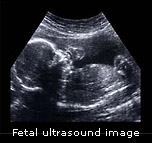What is an ultrasound?
Ultrasound is a non-invasive procedure that provides clear visualization of the fetus and surrounding structures. A valuable diagnostic tool in obstetrics, it can reveal the size (and therefore the gestational age) of the baby after six weeks, show the fetal position after 18 weeks and even detect many obvious physical abnormalities (such as a cleft lip or a heart defect). In addition, ultrasound provides the visualization necessary for performing other medical procedures, such as amniocentesis and turning a breech baby. Ultrasounds work on the same principle as sonar (used in oceanography to map the sea bed), in which sound waves are passed through the mother's abdomen to the fetus and then bounce back and create the fetal image on an electronic monitor.
Ultrasounds work on the same principle as sonar (used in oceanography to map the sea bed), in which sound waves are passed through the mother's abdomen to the fetus and then bounce back and create the fetal image on an electronic monitor.These high-frequency sound waves are absorbed and bounced back from human tissues, bones and body fluids (all with different densities) to make up the lighter or darker images on the monitor, depending on the density of the tissue it is scanning. The black areas indicate liquid mediums such as amniotic fluid; soft tissues appear grey while the denser tissue such as bones show up as white areas.






